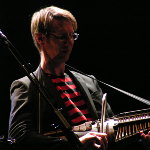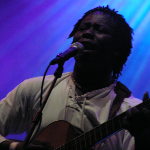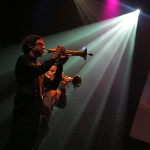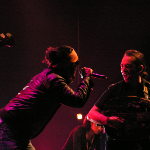WOMEX 2008
This article is dedicated to our colleague Christoph Moser who recently passed away while swimming during a vacation in Thailand, leaving his radiant musical soul to the Pacific Ocean. Christoph’s inspirational work at ‘HOANZL’, the well-known Austrian distribution and record company, is legendary. The last time I saw Christoph was at the WOMEX trade fair held last fall at ‘Fibes’ in Seville and only a few weeks later he was gone forever. His death represents an incredible loss for the Austrian music industry as genius like Christoph’s just isn’t found at every corner of the music biz world. Christoph’s inspirational influence on the Austrian singer/songwriter scene was immense as was his indelible impact on the promotion of world music to the Austrian music market. Without Christoph’s influential leadership many musical diamonds would have gone unnoticed by Austrian music customers. I was thankful when Christoph Moser added my favorite band, ‘Les Boukakes’, to his lineup at ‘HOANZL’ after which Gina Salis Soglio then booked ‘Les Boukakes’ for her program at the ((szene)). Wow to both Christoph and Gina for all the great work they have done together!
As mentioned already, the last WOMEX took place in Seville, Spain. Since 1994 the WOMEX project has managed an annual world music scene professional networking convention of the same name. The WOMEX event has traveled around Europe being held first in Berlin (1994) then in Brussels (1995), Marseille (1997), Stockholm (1998), Rotterdam (2001), Essen (2002, 2004) and Newcastle upon Tyne (2005). Seville was the host city four different years during which time the Seville WOMEX partners were able to perfect the concert halls, theatres and other venues where the lucky chosen bands performed for 2800 music professionals. The live sound set-ups had never been better than they were at WOMEX 2008.
In Seville in 2003 musical acts where shown at ‘l Palenque’, an open-air multi-stage complex situated in the space-age ‘Parque Tecnológico’ built for the Universal Expo ’92. Multi-stage means that one is able to listen to two bands simultaneously while standing in the middle of a hall in front of a third band desperately trying to do their sound check. At the 2006 WOMEX in Seville everything -- the trade-fair, conferences, day performances and the musical showcases -- happened in ‘Fibes’. The facilities at ‘Fibes’ – the beautiful, theatre-like stage, a small tent, the multi-stage hall plus a second hall – were an improved location yet some of the groups and their ethnic instrumentation made excessive demands of the sound engineers who obviously were not accustomed to world music sound monitoring. WOMEX arranged the best facilities for the presentation of showcases to the visitors and fans in 2007 and again in 2008 by utilizing ‘Teatro Lope de Vega’ plus two stages in tents located in the heart of the ‘Plaza de España’. The annual WOMEX event has grown steadily in size as evidenced by the large number of trade fair stands in 2008 at ‘Fibes’.
Anyone used to other music fairs may wonder why WOMEX only presents the exclusive number of 40 showcase acts for consideration by the 2800 delegates. This concept was an original tenet of the WOMEX founders which hasn’t been changed because it benefits the selected artists by providing them with a guaranteed audience at their showcase. The managements, labels and agencies who want their artists to be considered for selection as one of the WOMEX showcases must send a press-kit to the organization team and the annual changing jury known as the ‘7 samurai’ whose member’s level of professional experience helps them choose the most interesting acts, whether newcomers or stars, from hundreds of proposals.
In 2008 it was time for WOMEX to say goodbye to Seville as the event will move to Copenhagen in 2009. Therefore, the opening day’s program for 2008 was dedicated to Seville with an apropos presentation of the finest flamenco I have ever heard. The flamenco program took place at ‘Teatro Lope de Vega’, the location reserved for all official delegate events. After the welcoming speeches, Seville’s ‘Ultra High Flamenco’ performed a cool show of highly energetic flamenco. Although every member of this group previously had toured with famous flamenco stars such as Vicente Amigo and Gerardo Núñez, as a group ‘Ultra High Flamenco’ is a relative newcomer whose debut was in 2007. For those who preferred some drinks or dancing to modern flamenco disco sounds with breaks and beats, the place to be was the bar open to the terrace and where DJs ‘Los Rumbers’ were in command. Next to perform was Miguel Poveda, a master cantaor of flamenco’s young generation, and his performance was one not to be missed. Real flamenco aficionados stayed until the evening’s end enjoying exquisite Spanish tradition which one rarely gets to experience in one’s own country.
The days at the trade fair were packed with business while everyone delighted in meeting old friends and colleagues and in making new connections. Due to the limited space in my suitcases I hadn’t been able to pack enough copies of Sonic Pages Vienna for all the enthusiastic Womexicans who really loved our magazine and wished they had something like it in their own country. “Keep cool,” I said, “It will be available soon enough.” Unfortunately for me, there were so many offerings available each day I discovered it wasn’t possible to find enough time to attend all the interesting conferences, presentations and mentoring sessions which this year focused on the broad theme of digital music.
The atmosphere at the Austrian stand was cozy and often enthusiastic. 2008 marked the first time an Austrian band, ‘Fatima Spar and the Freedom Fries’, was chosen by the 7 Samurai to play a WOMEX showcase. ‘Fatima Spar and the Freedom Fries’ was the first act to perform in the tents on Thursday, a time which proved to be a bit challenging as at the beginning the audience slowly arrived. Nevertheless, the band did a great job entertaining the audience who seemed to really enjoy the outstanding voice of Fatima Spar plus the group’s inviting gypsy sounds moved many people to dance. ‘Fatima Spar and the Freedom Fries’ show, as well as the show of many other WOMEX showcase acts, was recorded by Emil Lubej for the Vienna-based internet radio Emap.fm.
To give bands that weren’t chosen by the jury a chance to display their talent there was Off-WOMEX, a place where showcases could be brought by managements wanting their artists heard by international agents and bookers. It was here I was pleased to discover Sweden presenting the Sami traditional songwriter Sofia Jannok who performed the seldom heard native form of yodeling called ‘joiken’.
Back at the outdoor pavilions in Seville’s Plaza de España I felt a strange impression of confusion upon hearing the driving beats of ‘Les Amazones de Guineé’. The audience was quite fascinated, as was I, watching the show by these women. Listening closely, I couldn’t help but think they’d rather use guns and rifles then guitar, bass and drums. The next day I talked to a German journalist who has lived and worked in Senegal for several years. She told me that she couldn’t imagine why the WOMEX jury had chosen this military band founded by a dictator as she felt it didn’t contain outstanding musicians.
The quality of the next formation I saw on the first evening was unquestionably better. Electric oud Champion Mehdi Haddab (Ekova, DuOud) introduced his new project ‘Speed Caravan’. He couldn’t have found a better name for the intense and colorful sounds that erupted from the stage like hot lava from a volcano.
The swinging ngoni (African lute) music of ‘Bassekou Kouyate & Ngoni ba’ was a worthy conclusion to the first evening. Their show, which left the audience happy and cheerful, was a light hearted and virtuous handling of the musical culture of Mali.
During the daytime, ‘Fibes’ was buzzing with business talks. During one of these conversations I was quite saddened to learn about the closing of the Berlin radio show ‘Radio Multikulti’. World music in Germany originated with the famous ‘3 Mustaphas 3’ and Colin Bass (former Camel), who was one of the founders of Radio Multikulti.
While on the subject of origins, it would be a shame to overlook ‘Die Dissidenten’. Although considered quite old, ‘Die Dissidenten’ appears to have reached a new height of creativity with their innovative album ‘Tanger Sessions’ which they recorded with the Moroccan heroes ‘Jil Jilala’ and to which they introduced me. Surprisingly, one can find fans who consider ‘Die Dissidenten’ to be a legend while others regard them as an interesting newcomer.
It was hard not to spend all day listening to great music at trade fair stands from all over the world. I preferred the bands who presented themselves so I soon ended up at the frivolously decorated stand of ‘El Puchero del Hortelano’. This group from Granada fancies a funny flamenco-gypsy-brass style. I offer congratulations to ‘El Puchero del Hortelano’ on their juicy CD cover for ‘Harumaki’.
At 5 p.m. each day I struggled with deciding whether to stay with the Croatian delegates and their slivovitz, my friends in ‘Dazkarieh’ with their excellent Portuguese red wine and cheese or to stroll around with my old Dutch friends Pieter Fransen and Bas Springer and sample some of the many culinary temptations.
My favorite show was held Friday evening in ‘Teatro Lope de Vega’: Sweden's premiere acoustic string trio ‘Väsen’ with the virtuous Appalachian mandolin player Mike Marshall presented a relaxed concert. Unfortunately Mike’s partner on the fiddle, Darol Adams, couldn’t come because he had broken his hand in a bike crash. His colleagues mentioned that musicians should be forced to only use public transportation.
Next I saw ‘Peret’, ‘Magnifico’, Aurelio Martinez and ‘Tumi and the Volume’. I had never heard any of them before and I enjoyed every single minute. Peret, the king of “rumba catalana” for decades, attracted a huge local community of fans. The Slovenian superstar and chameleon Magnifico split his audience. If one wasn’t familiar with Magnifico’s background including his constant fight against racism and sexism, it would have been easy to consider him a racist and sexist. Quite a few visitors left the tent because of ‘Magnifico’s’ video-show featuring topless go-go girls. Mr. Martinez from Honduras represented the Garifuna tradition of Honduras. He is an original member of the Garifuna All Stars Band and sang a beautiful duet with Andy Palacio, who died much too early in January 2008. I never expected to hear a band like ‘Tumi and the Volume’ at WOMEX so I must congratulate the jury for this selection. The ‘Volume’s’ fat breaks ‘n beats together with the powerful rap of South African singer ‘Tumi’ produced an earthquake on the stage.
The last evening at WOMEX was dedicated to Galician music. The driving bagpipe and fiddle tunes by ‘Muthenrohi’ and ‘Xosé Manuel Budiňo’ satisfied their audiences which included a group of Korean folk-music addicts who freaked out in the very front. Between these acts I swapped Spanish folk for Italian and listened to the Neapolitan saxophonist Enzo Avitabile and ‘I Bottari’. Unfortunately I got a bit bored after a while, although these Italian barrel drummers were a real attraction.
The last day of WOMEX was, as always, dedicated to the WOMEX award, the ‘Oscar of the world music community’. The award statuette is the replica of a mother goddess, created in the Neolithic age and found in modern Turkey, who symbolizes creativity and fertility (in the music-biz). For the award’s 10th anniversary, the jury presented two winners: ‘Muszikás’, the preservers of the Hungarian folk tradition (see Sonic Pages Vienna Vol. III, 2008, page 88), and the Folk Music Department of the Sibelius Academy in Helsinki. Since the famous harmonica quartet ‘Sväng’ (WOMEX showcase 2007) visits Austria frequently, this outstanding educational institution is well known. Jouko Kyhälä, the only harmonica specialist with an academic doctoral degree for this instrument, met Sonic Pages Vienna for an interview:
Sonic Pages:
Hi Jouko! As a graduate of the Sibelius Academy, please tell us something about the academy and what makes it special?
Jouko Kyhälä:
The Sibelius Academy, the only music university in Finland, has different departments. Folk music which I studied, jazz music, classical music of course, opera and all else that one would expect to find at a music university. Sibelius Academy holds the broad vision that all genres of music should be taught at an equal level which means jazz and folk music students are trained at a very high level.
Sonic Pages:
Finland produces a lot of successful folk musicians (like JPP, Maria Kalaniemi, Markku Lepistö and of course ‘Sväng’) who are well based in their Finnish traditions. Do you think the folk department of the academy is the reason for this?
Jouko:
Absolutely – the folk department was founded 1983 and if one looks at the top letters for professionals of folk music in Finland today, one will see that they have all been to the Academy. The vision of Heikki Laitinen, the professor who founded the folk department, reflects a deep understanding of folk music and respects old Finnish traditions. The influence of Laitinen’s vision, which is the basis and motivation for all that we do at the Sibelius Academy, is clearly recognizable in Finland’s folk music scene. It seems all the Scandinavian countries are following this vision today as well.
Sonic Pages:
How (and why) did you become a doctor of harmonica?
Jouko:
After graduating, I taught in the folk department for several years. I then realized that there was still much I didn’t know about my main instrument (I play a lot of instruments) and more I wanted to learn about harmonica plus I wanted to obtain a new level as an artist using this tiny instrument. At Sibelius Academy there exists the possibility to achieve a doctor of arts. Of course one can also get the traditional doctor of sciences in music theory, but because I had graduated as an artist I was allowed to continue studying as an artist.
Sonic Pages:
What is different in the educational process when you study as an artist?
Jouko:
The doctoral study of arts is a process which takes several years during which one doesn’t actually write a big book but instead does a series of five concerts. The concerts had to be planned so that the artist could continue developing to a certain skill level. What I did was always controlled by the seminars and the professors. It was very interesting to do this kind of doctoral study because I could focus all my energy on one big concert at a time and learn everything necessary to do the music I had planned to perform. I traveled to Germany and the States to meet people I knew who were much better than I. My studies lasted for four years and during this time I had the chance to learn what otherwise would have taken fifteen years.
Sonic Pages:
Did you already have ‘Sväng’ during the process of studying?
Jouko:
Yes and that was very fortunate. While learning new techniques on the harmonica, I could say: “Hey, let’s try this new approach together.” When I started my doctoral studies Sväng had already existed for a year. Sväng was my live-laboratory in which to immediately put into practice what I was learning. Of course it was also beneficial for the band to incorporate all these new techniques which no other harmonica band was using.
Sonic Pages:
What kind of techniques for example?
Jouko:
We tune our instruments differently which brings new colors to the sound of the harmonica.
Sonic Pages:
Do you teach these inventions of harmonica?
Jouko:
Although I haven’t taught since I finished my doctoral graduation, if a student appeared who was capable of learning these really advanced techniques, then I would teach him. However, I currently prefer to focus on music and touring with ‘Sväng’. The success of the band is fascinating to me because I never could have imagined that I would make a living by playing harmonica in a harmonica band.
Sonic Pages:
You had a showcase at WOMEX in 2007. Did it help you to get more international concerts?
Jouko:
It was very important for us to play at WOMEX and quite a boost for ‘Sväng’. Pekka Lethi, our label manager, had been going to WOMEX for years on behalf of his label and our group. Of course we had hoped to be chosen, yet we were still surprised when this wish came true.
Sonic Pages:
Did you make contact with your Austrian agent Anne Hofstadler of Triart at WOMEX?
Jouko:
No, we met at the Austrian Festival Glatt & Verkehrt after a concert. Since then Anne has brought us to Austria many times and we always enjoy playing there. This year we’ll return to Austria in March and our tour-dates can be found at www.triart.at.
by Nicole Janß , edited & proofed by Leslie Fairbrother
article posted by:Nicole Janss, Sonic Pages Vienna







